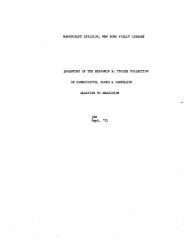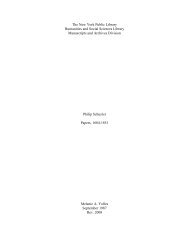pdf available - Multiple Choices
pdf available - Multiple Choices
pdf available - Multiple Choices
You also want an ePaper? Increase the reach of your titles
YUMPU automatically turns print PDFs into web optimized ePapers that Google loves.
66 LUBOML<br />
these schools, but, once the schools were established,<br />
some Libivner Jews fought against them<br />
with all their might.<br />
As a weapon in this struggle, some Libivner<br />
Jews contemplated establishing a modern Jewish<br />
religious school for children, conducted in the<br />
Orthodox spirit. They therefore founded in<br />
Libivne a Yavneh school, though that came much<br />
later. The Tarbut school was founded in the early<br />
1920s, while the Yavneh school began to function<br />
in the mid-thirties. It was only in a report of 1937<br />
that first mention was made of the Libivne<br />
Tachkmoni (meaning "wisdom" or "academy")<br />
school, which affiliated with the Mizrachi-sponsored<br />
Yavneh schools in Poland."<br />
Some Orthodox Jews of the shtetl were not<br />
satisfied with the struggle against Tarbut or with<br />
their efforts to support the old chinuch-mosdot in<br />
town. Instead, they wanted to expand even further<br />
local Torah education.<br />
After much effort, they succeeded in setting<br />
up in Libivne a yeshiva k'tana [small yeshiva],<br />
fashioned on the Novorodka type. They engaged<br />
Rabbi Noach Katzman as head of the yeshiva. In<br />
a letter dated the 18th day of Nisan, 1933, sent by<br />
the Libivne Va' ad HaYeshivot (Yeshiva Committee)<br />
to the Lutsk Regional Yeshiva Committee, it<br />
was written that the town needed funds to bring<br />
the head of the yeshiva and his family to Libivne.<br />
The letter was signed by the members of the<br />
Libivner Yeshiva Committee: R. Arye Leybish<br />
HaCohen London, Avrom Sheyner, Moyshe Wein,<br />
Henech Friedman (the rest of the names are<br />
illegible).<br />
Another letter asking for help for the yeshiva<br />
ktana was sent to the regional committee of Va'ad<br />
HaYeshivot, headquartered in Vilna. The letter<br />
was penned by Libivne's other rabbi, R. Pinchas<br />
Oselka.<br />
In 1935, other members were co-opted to the<br />
Libivne Va'adHaYeshivot: Reuven Tuzman (head<br />
of the Noach Katzman Yeshiva), Matityahu<br />
Melnitser, Meyer Shoychet, Beynish Melamed.<br />
In 1936, the Libivne Va'ad HaYeshivot was<br />
reorganized. New names were added to the membership:<br />
the newly elected young rabbi, Alter<br />
London, Kalman Meyler, Emanuel Yarin-<br />
Kesboym, Meyer Sandlshteyn, Dovid Katz,<br />
Liptsye Gleizer, Pinchas Granatshteyn, Avrom<br />
Tzvi Tzukerman.<br />
In a letter sent by the Libivne Va'ad<br />
HaYeshivot, local Jews kept complaining that the<br />
yeshiva ktana was in financial trouble because<br />
the Metzudat Yeshiva Lublin kept pushkes [charity<br />
collection boxes] in every home!"<br />
Out-of-town students of the yeshiva ktana<br />
used to esn teg (" eat days" [have meals at various<br />
Jewish homes in the shtetl]. One rabbi of the<br />
yeshiva was Reb Zalman, who married the daughter<br />
of Chayim Fisher, Rivke Tzimmerboym. The<br />
yeshiva ktana existed until the Holocaust.<br />
We must mention here that the religious<br />
institutions of the shtetl, besides receiving regular<br />
support from outside Jewish organizations,<br />
also received help from the Jewish-American<br />
Ezrat-Torah, which supported many religious<br />
organizations in Eastern Europe in the postwar<br />
period.<br />
During the first few years after the war, funds<br />
were sent to the dayan [judge] R. Yehuda Leyb<br />
(Leybl) Melamed for distribution."<br />
Political Parties<br />
During the time of the independent Polish<br />
state (1918-39), political parties were a most<br />
dynamic force within Jewish social life in<br />
Luboml. There were many Jewish parties, but<br />
the majority of themthe most active and the<br />
most influentialwere those which belonged<br />
to the Zionist movements or that were concentrating<br />
their efforts on preparing to rebuild<br />
Eretz Yisroel [the Land of Israel].<br />
Of all these Zionist parties, the most lively and<br />
most active were the Zionist youth organizations:<br />
HaShomer HaTsair, HeChalutz, and Beitar.<br />
The first such party created in Libivne was<br />
Poale Tsion, with Hershl Chasid at its head.<br />
The first Zionist youth organization in Libivne<br />
was the HaShomer HaTsair. Its founders were<br />
Yisroel Grimatlicht (Garmi), Berl (Bebi) Veyner,<br />
Nathan Blumen, Zalman Fisher, Leibele Melamed,<br />
Eliyohu Frechter, Shmuel Barg,Yitshak Shneider,<br />
Moyshe Volvushes, Dobrovodke, and Yakov<br />
Blumen.<br />
In the beginning (1919-20), the majority of<br />
the HaShomer HaTsair members were girls-60<br />
of them. They were organized in kvutzot. The<br />
leaders of the kvutzot were Nechome Veyner,







